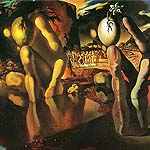Dreams and Dali

Dreams and Dali
“For in dreams we enter a world that is entirely our own. Let them swim in the deepest ocean or glide over the highest cloud.”
– Albus Dumbledore (J.K. Rowling), Harry potter and the Prisoner of Azkaban
Since I was a kid, dreams have always intrigued and fascinated me. I tried to find some rational explanation for the occurrence of dreams, through books and documentaries. But I couldn’t find a rational explanation.

Persistence of memories
In ancient times, when science was hazy, people used to wonder and were in awe with nature, aspects of weather and celestial bodies. As science progressed and we came to know the science and the mechanism behind things, things lost a bit of the mysticism.
I’m not saying that autumn or foggy hills aren’t beautiful, after you know the science behind it. All I’m saying is that we are generally keener to know things which are unknown, pursue the things which are yet not attained and experience things which were not experienced before.
I have often wondered what language we use when dreaming. Most of the time, I think it is the language we use, in our daily lives. But do we use languages, which we know but don’t use that often?
You will find in the books that dreams are manifestations of the conscious and the unconscious mind. But there are dreams, which are vague. I understand that people don’t remember places, people or incidents, yet there are some dreams, which not only have vague places, people or incidents, but concepts; concepts that are never imagined by us. Perhaps, we have the power of manifestation and progression of thoughts in dreams too.

Metamorphosis of Narcissus
If you want an example, of the conceptual vagueness, you should look at some of the paintings by Dali, which were inspired by his dreams. They have very earthly objects, places and people, but they are twisted in such a manner, which can’t be a part of conventional imagination. They were called paintings of ‘beyond realism’, or ‘surrealism’. Like the melting clock in the painting “Persistence of Memories”. Who could have imagined a melting clock in their conscious minds! Similarly, the face like object in the painting is a product of the subconscious. The conscious mind cannot have the inception to think of something as incredible as this.
If you look at some other paintings of Dali, like “The metamorphosis of narcissus”, you will, perhaps, be able to see the associative tendency of our minds, in terms of shapes and objects. The painting is divided in two halves. The first one shows the destruction of Narcissus, where he is looking at his reflection, the other which constitutes the same basic shape of that of Narcissus, but shows Generation, rather than destruction, the whole painting is vague and dreamlike, made out of random objects, sometimes these objects don’t make sense.
Everything was (and a larger part of I still remains) vague and mystical, and that is the beauty of it. I used to maintain a dream Diary, where I used to write about all of my dreams that I could remember, after waking up. Sometimes, things that couldn’t be explained via words were drawn in the diary. I still pen down some of the really interesting dreams. The strange thing is, I didn’t know about Dali, back then. When I first saw Dali’s paintings, it made me float in my dreams, for a brief moment. Before even reading about Dali, I understood that he paints his dreams.
The abstract dreams will continue to take space in my mind, my life, my diaries and my list of unanswered questions, even if they solved the mystery of dreams. Some claim that they have. But I can’t seem to believe in them, because, you can only understand a dream when you’re dreaming. In that moment, even the weirdest of dreams make sense. Once you wake up, the explanations would consist of words and logic, which will never be able to explain the essence of the world you were in.
So the secret of dreams lies in dreams itself. Once you are out of it. That secret projects itself so feeble and meaningless, that people would find it funny, vague and insignificant.
In the end, the thing that can come closest in explaining the dream in consciousness, is through paintings.







